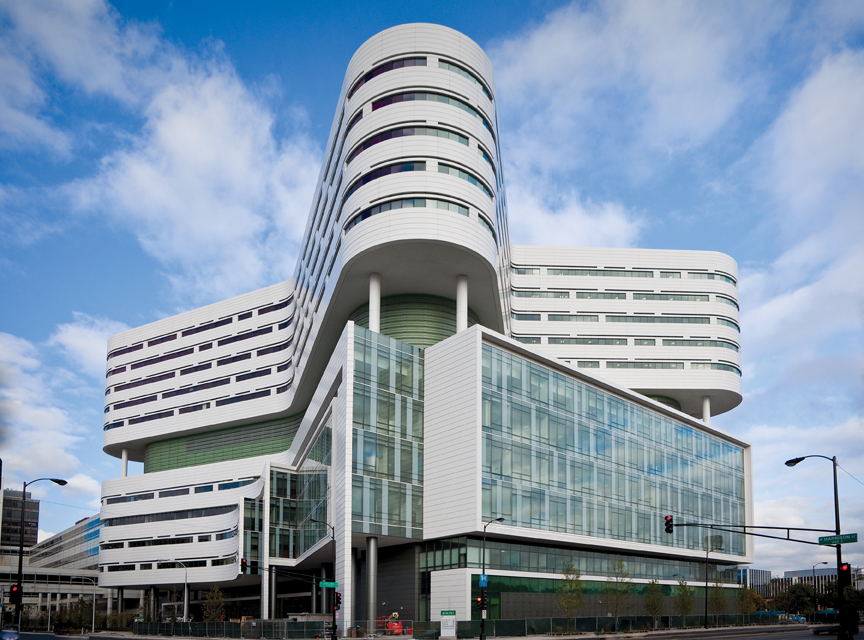2012 Building Team Awards
Platinum Award
Six years ago, and worlds away in terms of economic conditions, Rush University Medical Center unveiled ambitious plans for a 10-year campus redevelopment project on the Near West Side of Chicago. At a cost of $654 million, the cornerstone of the transformation was an 840,000-sf, 14-story butterfly-shaped hospital building, called the Tower, that included a technologically advanced emergency room prepared to handle any type of pandemic or chemical, biological, or radiological disaster that might strike Chicago.
In July 2008, steel erection was nearly 30% complete when the global financial crisis hit. Rush officials were concerned they might not be able to obtain the necessary funding to complete the project.
The Building Team, led by the Power/Jacobs Joint Venture—an affiliation of Power Construction Co., Schaumburg, Ill., and Jacobs Engineering Group, Pasadena, Calif. (PM/CM), and architect Perkins+Will, Chicago—worked to develop a financial plan that would allow the project to keep moving. A multi-prime contracting strategy enabled the Building Team to award contracts to multiple prime contractors based on when the work was ready to be bid and start. More to the point, the plan was flexible enough to slow down or stop construction at any time without committing to the balance of the contracts.
As construction proceeded during the economic meltdown, the Building Team was able to help Rush remain on course financially while pushing the limits of value-added engineering and construction.
In late 2011, Rush and the Building Team unveiled a LEED-NC Gold tower that was completed on time and within budget, thanks, in part, to the multi-prime contracting strategy.
In singling out Rush University Medical Center by awarding a Platinum designation, the judges for Building Design+Construction’s 2012 Building Team Awards recognized the Rush Building Team for overcoming the unforeseen financial constraints, developing a structural redesign of the tower that saved Rush $40 million, and completing one of the most innovative emergency response centers in the U.S.
“For a job of that size to get done during the recession is pretty impressive,” says Building Team Award Judge Jeremy Oremland, a financial analyst with Magellan Development Group LLC, Chicago.
COLLABORATION ON DESIGN CONCEPT, STRUCTURAL COMPLICATIONS
Perkins+Will worked closely with hospital clinicians during the design phase to create a new hospital building that would embrace patient comfort, safety, efficiency, and quality of care—ultimately, a facility that would house 304 acute care and critical care beds, 72 private neonatal intensive care rooms, 28 operating rooms, 14 procedure rooms, and 10 labor, delivery, and recovery rooms.
“Rush’s Office of Transformation organized task forces chaired by selected leaders from the client side, who met over the course of several months with the Building Team to discuss specific aspects and departments of the project,” says Bridget Lesniak, AIA, a principal with Perkins+Will.
Task forces for each department met with the Building Team to plan layouts that accentuated the hospital’s best operational practices while discouraging inefficient ones.
For example, the Hospital Building Standards task force reviewed architectural and MEP systems for all typical rooms, which provided vital information regarding operations, product selection, liability, infection control, and clinical concerns. “Especially standardization, which was the main driver for this project,” says Lesniak.
The innovations developed between the Office of Transformation and the Building Team included:
- The butterfly shape, which gives nurses a clear sightline to patient rooms and puts them closer to patients.
- Operating-room quality air throughout all patient care areas, and even higher quality air circulation in surgical suites.
- Single-bed rooms designed with separate zones for the patient, the patient’s family, and staff. Patient rooms have a uniform design, so physicians and nurses will find the same equipment in the same place to ensure seconds are not lost in an emergency.
GETTING THE TOWER TO SIT RIGHT
Meanwhile, the structural design for the 14-story Tower faced complications. Initial designs had its base connected directly to the basement of Rush’s existing hospital building, which extended 30 feet under the new facility.
“The lower level of the existing building extended a significant distance below grade in the direction of the new addition,” says Lesniak. “Attempting to put in foundations for a 14-story building in this location would have been very expensive and extremely time consuming.”
The Building Team assembled for a constructability and value engineering session. The solution: pull the two buildings apart and redesign the new hospital building.
Project summary
PLATINUM AWARD
Rush University Medical Center Transformation Program – Tower (Phase II), Chicago, Ill.Building Team
Submitting firm: Power/Jacobs Joint Venture
Owner/developer: Rush University Medical Center
Architect: Perkins+Will
Structural engineer: Thornton Tomasetti
MEP engineer: Environmental Systems Design
General contractor/Construction manager: Power/Jacobs Joint Venture, Rush UniversityGeneral Information
Size: 840,000 sf
Construction cost: $654 million
Construction period: July 2008 to July 2011
Delivery method: PM/CM agency multi-prime
Separating the new and existing hospital structures actually simplified the foundations, eliminated supercolumns, and allowed a rectilinear column grid that eliminated the need for a transfer truss system. A multistory bridge was built to connect the Tower back to the existing building, a structural redesign that saved more than $40 million and resulted in a more finely engineered building with no reduction in scope.
The newly created space between the two buildings allowed for the inclusion of the three-story, 10,000-sf Edward A. Brennan Entry Pavilion, made possible through $16 million in private donations. It features a four-story terrarium that is open to the elements, circular skylights that provide natural lighting, seating areas, and a centrally located reception area.
Even though it was a late addition to the Rush transformation program—the Tower’s steel and concrete structure was complete and 50% enclosed—the Brennan Entry Pavilion was finished three months ahead of schedule and in time for the grand opening.
Other cost-saving efforts by the Building Team included:
- The application of simulation modeling to review and validate the operational space program, which led to improvements in the utilization of numerous spaces—saving $7.8 million.
- A strategy for mitigating floor moisture to avoid the application of accelerants—saving $5 million.
- Reengineering the support steel for patient lifts and booms and lights—saving $1.05 million.
- Negotiating consultant and contractor proposals—saving $26 million.
MILITARY APPROACH TO THE EMERGENCY DEPARTMENT
Unique to the Rush new facilities is the first-floor Emergency Department, which houses the Robert R. McCormick Foundation Center for Advanced Emergency Response.
“This is the nation’s first facility designed to provide care for patients involved in chemical, biological, and radiological disasters,” says Dr. Dino Rumoro, Rush’s chair of emergency medicine. “We have to be ready for any type of disaster that can hit the city of Chicago.”
Modeled after a military emergency command center, the room measures 40,000 sf and includes 60 beds in three pods of 20 rooms each. Each patient room is fitted with a double set of gas and electrical outlets. In the event of a mass casualty situation, two patients can be placed in each room.
In case extra capacity is needed, gas and electrical outlets are hidden behind panels on columns in the adjacent Edward A. Brennan Entry Pavilion.
“Many new emergency departments are building in disaster response features, but none to the capacity that we have done by incorporating large-scale decontamination, respiratory infectious illness, and surge capacity,” says Dr. Rumoro.
Traditional emergency rooms have decontamination areas and showers to serve up to six patients. Rush’s emergency response center can serve and decontaminate several hundred patients in one hour. The ambulance bay can also be closed to vehicles, and decontamination showers can be set up to wash down large numbers of patients simultaneously. Contaminated water is collected in a 10,000-gallon tank rather than directly discharged into the city sewer system.
“The hope is Rush developed a model for future emergency department design and Centers for Advanced Emergency Response will be required in the future for hospitals in large population centers,” says Dr. Rumoro.
At a ceremony for Rush’s new Tower in December 2011, Dr. Larry Goodman, CEO of Rush, said, “This was a dedicated team effort by our board, staff, and management to create a 10-year plan to address our needs while improving clinical care.”
Building Team Award Judge Peter Rumpf, integrated construction manager for Mortenson Construction, Elk Grove Village, Ill., echoed Goodman’s comments: “It was a very complex job that took a lot of collaboration and communication between the owner and the Building Team in order to successfully complete the project.” BD+C
--
Click here to view exclusive video interviews of the 2012 Building Team Awards judges explaining their selections.
Related Stories
Museums | Aug 11, 2010
Design guidelines for museums, archives, and art storage facilities
This column diagnoses the three most common moisture challenges with museums, archives, and art storage facilities and provides design guidance on how to avoid them.
| Aug 11, 2010
Broadway-style theater headed to Kentucky
One of Kentucky's largest performing arts venues should open in 2011—that's when construction is expected to wrap up on Eastern Kentucky University's Business & Technology Center for Performing Arts. The 93,000-sf Broadway-caliber theater will seat 2,000 audience members and have a 60×24-foot stage proscenium and a fly loft.
| Aug 11, 2010
Citizenship building in Texas targets LEED Silver
The Department of Homeland Security's new U.S. Citizenship and Immigration Services facility in Irving, Texas, was designed by 4240 Architecture and developed by JDL Castle Corporation. The focal point of the two-story, 56,000-sf building is the double-height, glass-walled Ceremony Room where new citizens take the oath.
| Aug 11, 2010
Carpenters' union helping build its own headquarters
The New England Regional Council of Carpenters headquarters in Dorchester, Mass., is taking shape within a 1940s industrial building. The Building Team of ADD Inc., RDK Engineers, Suffolk Construction, and the carpenters' Joint Apprenticeship Training Committee, is giving the old facility a modern makeover by converting the existing two-story structure into a three-story, 75,000-sf, LEED-certif...
| Aug 11, 2010
Utah research facility reflects Native American architecture
A $130 million research facility is being built at University of Utah's Salt Lake City campus. The James L. Sorenson Molecular Biotechnology Building—a USTAR Innovation Center—is being designed by the Atlanta office of Lord Aeck & Sargent, in association with Salt-Lake City-based Architectural Nexus.
| Aug 11, 2010
San Bernardino health center doubles in size
Temecula, Calif.-based EDGE was awarded the contract for California State University San Bernardino's health center renovation and expansion. The two-phase, $4 million project was designed by RSK Associates, San Francisco, and includes an 11,000-sf, tilt-up concrete expansion—which doubles the size of the facility—and site and infrastructure work.
| Aug 11, 2010
Goettsch Partners wins design competition for Soochow Securities HQ in China
Chicago-based Goettsch Partners has been selected to design the Soochow Securities Headquarters, the new office and stock exchange building for Soochow Securities Co. Ltd. The 21-story, 441,300-sf project includes 344,400 sf of office space, an 86,100-sf stock exchange, classrooms, and underground parking.
| Aug 11, 2010
New hospital expands Idaho healthcare options
Ascension Group Architects, Arlington, Texas, is designing a $150 million replacement hospital for Portneuf Medical Center in Pocatello, Idaho. An existing facility will be renovated as part of the project. The new six-story, 320-000-sf complex will house 187 beds, along with an intensive care unit, a cardiovascular care unit, pediatrics, psychiatry, surgical suites, rehabilitation clinic, and ...
| Aug 11, 2010
Colonnade fixes setback problem in Brooklyn condo project
The New York firm Scarano Architects was brought in by the developers of Olive Park condominiums in the Williamsburg section of Brooklyn to bring the facility up to code after frame out was completed. The architects designed colonnades along the building's perimeter to create the 15-foot setback required by the New York City Planning Commission.








